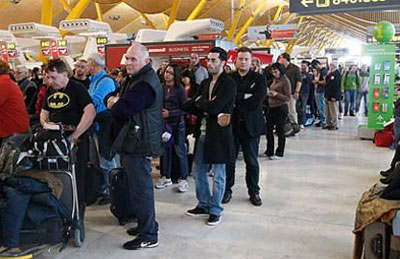
Global air traffic soars 5.3pc in August
Geneva, September 30, 2012
International air passenger traffic rose by 5.3 per cent in August year-on-year, led by strong growth from Middle Eastern airlines, according to the International Air Transport Association (IATA).
The IATA in its monthly report pointed out that the Middle East carriers were once again the strongest performers, and continue to expand rapidly - particularly on long-haul segments.
However the August growth rate of 16.7 per cent could have been boosted by the impact of Ramadan falling across the whole of August last year, said the report.
According to IATA, the capacity expanded by 13.3 per cent which took load factors to 78.4 per cent.
On the global scenario, IATA said the demand for air transport continued to flatten-out in August, but with significant regional variations.
Freight volumes too shrank as business and consumer confidence continued to slip, said its top official.
“Passenger markets have not grown since June and global air freight volumes are below previous year levels. In the face of these adverse conditions, disciplined capacity management has kept load factors high," remarked Tony Tyler, IATA’s director general and CEO.
"There are always opportunities and some parts of the world are growing. But, overall, trading conditions are tough," he noted.
This partly reflects a positive distortion owing to the timing of Ramadan. Adjustment for such seasonal fluctuations reveals that passenger demand has been basically flat since June and with only a 1.2 per cent expansion since January.
The carriers continued to moderate capacity expansion, limiting it to 4.1 per cent growth, taking load factors to 82.1 per cent. August air freight volumes fell 0.8 per cent compared to the previous year.
The minor recovery seen at the start of the year has faded quickly and the stability seen in freight markets during 2012 could be under threat owing to continued economic weakness.
The Middle East, African and North American carriers bucked the trend and remained in positive growth territory (11.3 per cent, 10.2 per cent and 2 per cent, respectively). All other regions saw freight volumes decline, the most significant being for Asia-Pacific carriers at 5.5 per cent.
According to IATA, the growth trend for international traffic remains weak, with overall expansion of 5.3 per cent heavily dependent on seasonal factors. Compared to July, August growth was flat, and load factors were down, it added.
Asia-Pacific carriers appear particularly affected, as airlines face strong competition and shifting trade flows. However, European airlines recorded strong demand growth in August (5.6 per cent), ahead of the 4.7 per cent expansion seen in July.
Despite recession conditions in Europe, airlines in the region have continued to expand on international routes, growing capacity by 4.4 per cent. Load factors rose marginally to 84.9 per cent.
North American airlines saw just 0.5 per cent growth in demand while capacity was reduced by 0.5 per cent compared to the previous August. This increased load factors by 0.8 percentage points to 86.9 per cent, comfortably the highest among the regions. Compared to July there was a 0.5 per cent increase in demand.
Asia-Pacific carriers were among the weakest in terms of demand growth reporting a 2.9 per cent growth in demand compared to a year ago.
On the freight scenario, IATA said compared to last August, the global demand fell by 0.8 per cent, behind a capacity expansion of 0.4 per cent, and declines in business confidence signal potential further weakness in the months to come.
The strongest performers for air freight were carriers from the Middle East, Africa and (to a lesser extent) North America. Freight demand for Asia-Pacific, European, and Latin American airlines contracted compared to last August, said the report.
Middle East carriers saw an 11.3 per cent increase in demand against a 10.4 per cent increase in capacity. This was the strongest performance.
At a global level, Tyler said, the airline industry fortunes track developments in the global economy.
“Sluggish growth in the US, the continuing sovereign debt crisis in Europe and concerns over the slowdown in the Chinese economy are taking their toll on both business and consumer confidence. Airlines have responded with, among other things, careful capacity management," he remarked.
"While global passenger traffic was up 5.1 per cent on the previous August, capacity increases trailed with a 4.1 per cent expansion. Along with this, conserving cash and controlling costs are the focus of most airlines as they await more favorable economic conditions,” he added.
IATA currently forecasts a collective $30 billion profit for airlines in 2012 for a 0.5 per cent net margin.-TradeArabia News Service







